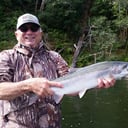In what country would you find the mouth of the Yukon River?
The Yukon River is a major watercourse of northwestern North America. The source of the river is located in British Columbia, Canada, from which it proceeds to flow through the Canadian Yukon Territory (itself named after the river). The lower half of the river lies in the U.S. state of Alaska. The river is 3,190 kilometres (1,980 mi) long and empties into the Bering Sea at the Yukon-Kuskokwim Delta, in Alaska. The average flow is 6,430 m³/s (227,000 ft³/s). The total drainage area is 832,700 km² (321,500 mi²), of which 323,800 km² (126,300 mi²) is in Canada. The total area is more than 25% larger than Texas or Alberta.
The Yukon River has had a history of pollution from gold mining, military installations, dumps, wastewater, and other sources.[citation needed] However, the Environmental Protection Agency does not list the Yukon River among its impaired watersheds, and water quality data from the U.S. Geological Survey shows relatively good levels of turbidity, metals, and dissolved oxygen.
In 2017 the course of the river was dramatically changed by a meltingglacier, probably caused by climate change.
More Info:
en.m.wikipedia.org














